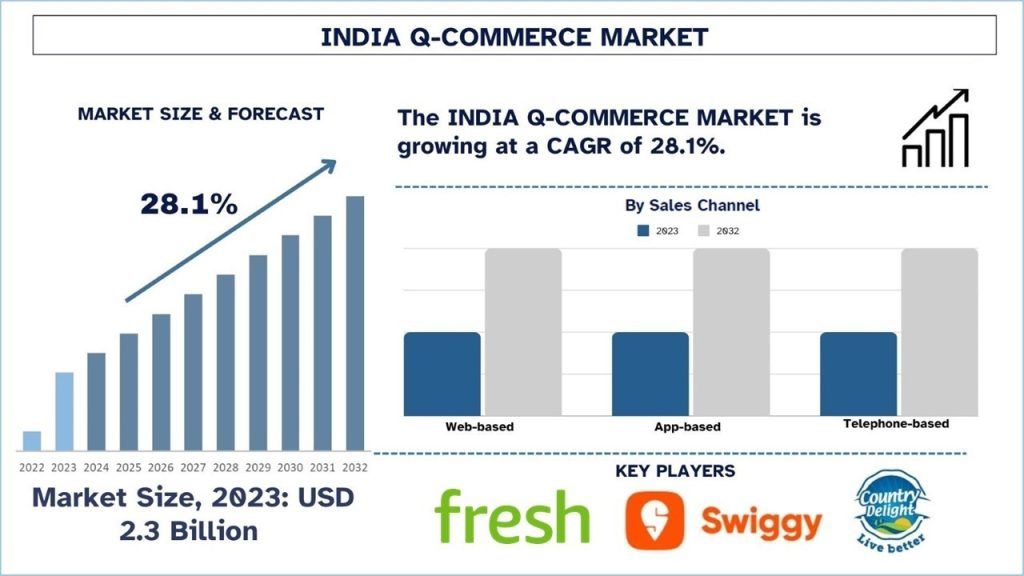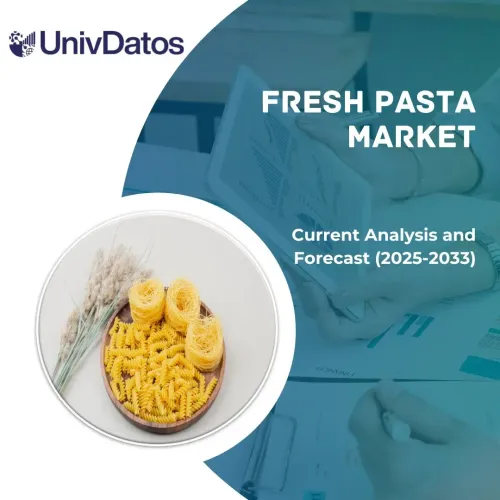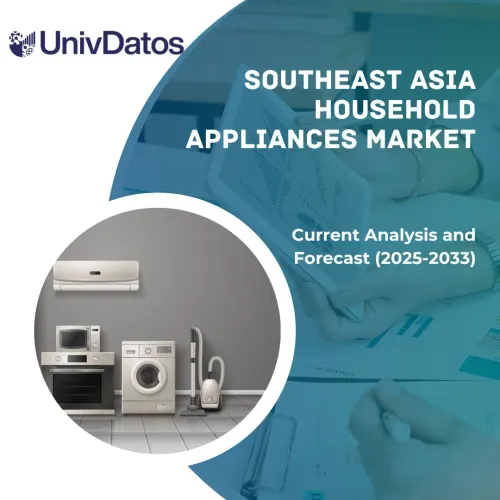- Home
- About Us
- Industry
- Services
- Reading
- Contact Us
India Q-Commerce Market: Current Analysis and Forecast (2024-2032)
Emphasis on Product Type (Grocery, Food & Beverages, Personal Care Products, Household Products, and Others); Sales Channel (Web-based, App-based, and Telephone-based); Region
India Q-Commerce Market Size & Forecast
The India Q-Commerce market was valued at USD 2.3 billion in 2023 and is expected to grow at a strong CAGR of around 28.1% during the forecast period (2024-2032) owing to rising penetration of the internet in the nation.
India Q-Commerce Market Analysis
The quick commerce business in India has emerged as a niche segment in the fast-growing e-business segment aimed at the delivery of groceries and other essentials to consumers in half an hour to an hour. Due to the growth of urbanization, shifting customer preferences, and the need for improved purchasing experience, this market group has steadily grown significantly, especially after the COVID-19 pandemic. Major players include Zomato, Swiggy, Blinkit, and Dunzo, where companies struggle to grab the consumer’s attention in today’s fast-growing market. New technologies are helping to improve the supply chain and use of data and enabling better delivery of services to clients.
Recent Developments in the Market
In July 2023, Swiggy acquired Lynk Logistics by buying a stake from Ramco Group. Lynk will continue to operate as an independent business. With this acquisition, Swiggy entered India’s food and grocery retail market.
In June 2022, Zomato acquired Blinkit (formerly Grofers) for USD 568 million in an all-stock deal.
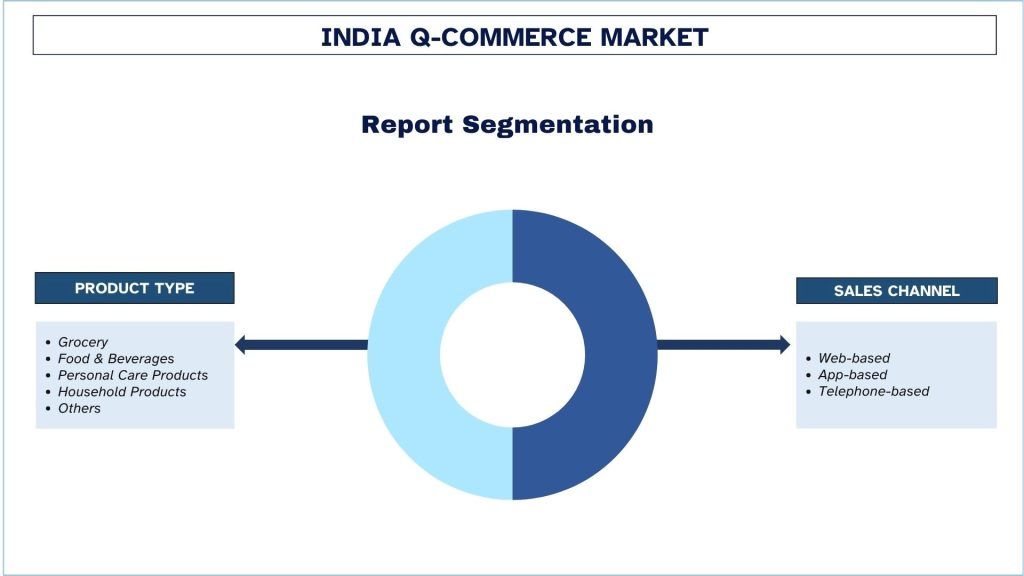
India Q-Commerce Market Trends
This section discusses the key market trends that are influencing the various segments of the pet perfume market, as identified by our team of research experts.
The Personal Care Products Segment Transforming Industry
The segment of personal care products is steadily experiencing rising popularity in India’s quick commerce segment due to people’s increased focus on hygiene and health, especially in big cities. Because convenience has become a priority for consumers, companies have adapted to solving every small need and now offer everything, from skincare and haircare products to hygiene products. Moreover, having readily available, easy access to all these has been warranted by changes in lifestyles as well as an influx of social media that champions elegance and glamour of beauty and wellness. Also, through the applications, it is convenient to repeat the purchase of personal hygiene products, so it is easier to maintain hygiene. Since this segment will continue to expand in the coming years, it will be able to significantly influence the direction of quick commerce, primarily addressing the changing needs of conscious buyers throughout India.
West India is Expected to Grow with Significant CAGR During Forecast Period
The quick commerce market especially in the western part of the country has also been growing aggressively well supported by high population density in urban areas and growing consumer preference for convenience. And there are so many cities that are providing demand for quick commerce services like Mumbai, Pune, and Ahmedabad, and many more and these platforms like Swiggy, Zomato Blinkit in short span are growing enormously. The region’s transport and logistics networks are well-developed meaning that quick commerce delivery is more accomplished in the region. Further, because of the emergence of smart consumers particularly the young generation, there is a preference shift in procuring groceries and other daily necessities online. The quick commerce market in West India to grow furthermore embedded into the trying business conditions and sustain growth with the constant adaptation of local preferences by companies.
In October 2024, beauty retailer Nykaa launched a 10-minute delivery pilot in Borivali, Mumbai, as the rapid growth of quick commerce started disrupting multiple product categories, pushing vertical players to find ways to drastically speed up deliveries.
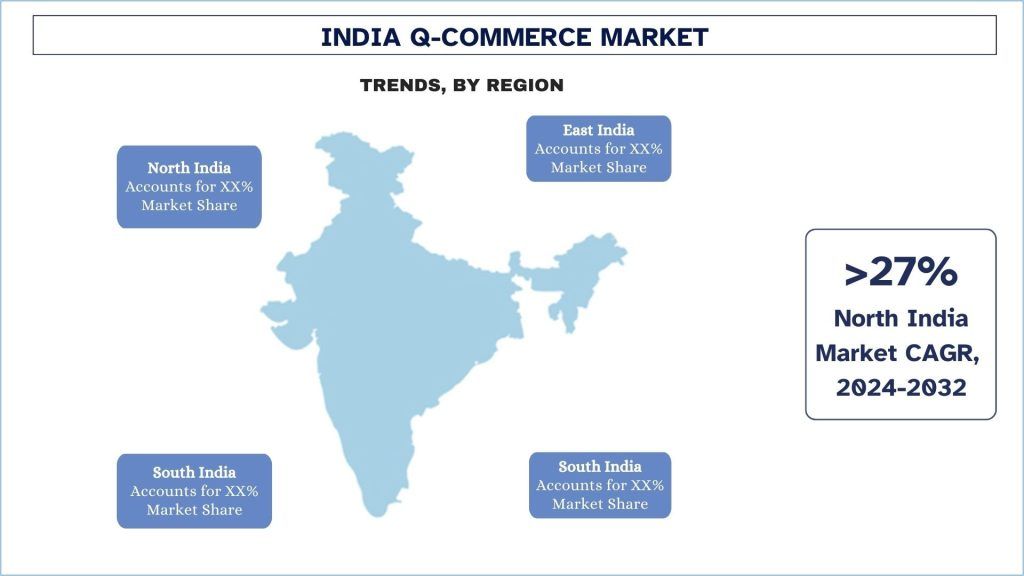
India Q-Commerce Industry Overview
The India Q-Commerce market is competitive and fragmented, with the presence of several country market players. The key players are adopting different growth strategies to enhance their market presence, such as partnerships, agreements, collaborations, new product launches, geographical expansions, and mergers and acquisitions. Some of the major players operating in the market include Swiggy; Zepto; Flipkart Minutes; Dunzo Digital Private Limited; Supermarket Grocery Supplies Pvt Ltd; Licious; Country Delight; Amazon Fresh Store; JioMart; Blink Commerce Private Limited.
India Q-Commerce Market News
In October 2024, Reliance Retail initiated efforts to enter the thriving quick commerce market in a move that is set to escalate competition for Zomato-owned Blinkit, Swiggy Instamart, and BigBasket, among others. The country’s largest retailer has started offering quick commerce services in select areas in Navi Mumbai and Bengaluru through its e-commerce platform JioMart since last weekend.
In March 2023, Kitchens@, a player in the rapidly growing cloud kitchen industry acquired Swiggy’s Access Kitchens business through a share swap deal.
India Q-Commerce Market Report Coverage
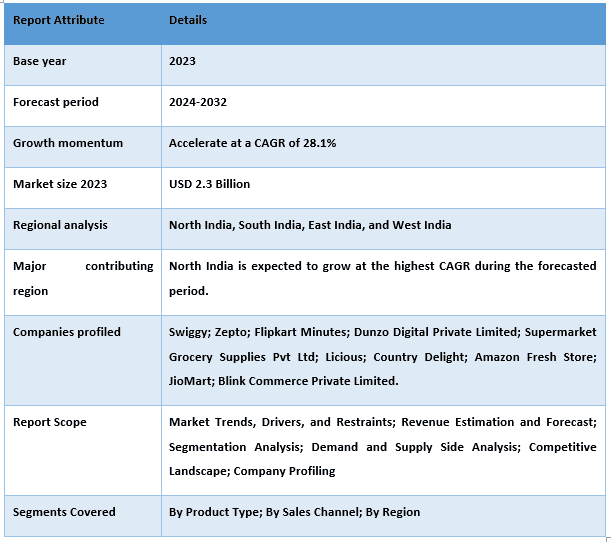
Reasons to buy this report:
- The study includes market sizing and forecasting analysis validated by authenticated key industry experts.
- The report presents a quick review of overall industry performance at one glance.
- The report covers an in-depth analysis of prominent industry peers with a primary focus on key business financials, product portfolios, expansion strategies, and recent developments.
- Detailed examination of drivers, restraints, key trends, and opportunities prevailing in the industry.
- The study comprehensively covers the market across different segments.
- Deep dive regional level analysis of the industry.
Customization Options:
The India Q-Commerce market can further be customized as per the requirement or any other market segment. Besides this, UMI understands that you may have your own business needs, hence feel free to connect with us to get a report that completely suits your requirements.
Table of Content
Research Methodology for the India Q-Commerce Market Analysis (2024-2032)
Analyzing the historical market, estimating the current market, and forecasting the future market of the India Q-commerce market were the three major steps undertaken to create and analyze the adoption of India Q-commerce in major states. Exhaustive secondary research was conducted to collect the historical market numbers and estimate the current market size. Secondly, to validate these insights, numerous findings and assumptions were taken into consideration. Moreover, exhaustive primary interviews were also conducted, with industry experts across the value chain of the India Q-commerce market. Post assumption and validation of market numbers through primary interviews, we employed a top-down/bottom-up approach to forecasting the complete market size. Thereafter, market breakdown and data triangulation methods were adopted to estimate and analyze the market size of segments and sub-segments of the industry pertaining to detailed methodology is explained below:
Analysis of Historical Market Size
Step 1: In-Depth Study of Secondary Sources:
A detailed secondary study was conducted to obtain the historical market size of the India Q-commerce market through company internal sources such as annual reports & financial statements, performance presentations, press releases, etc., and external sources including journals, news & articles, government publications, competitor publications, sector reports, third-party database, and other credible publications.
Step 2: Market Segmentation:
After obtaining the historical market size of the India Q-commerce market, we conducted a detailed secondary analysis to gather historical market insights and share for different segments & sub-segments for major regions. Major segments are included in the report as product type, sales channel, and regions. Further country-level analyses were conducted to evaluate the overall adoption of testing models in that region.
Step 3: Factor Analysis:
After acquiring the historical market size of different segments and sub-segments, we conducted a detailed factor analysis to estimate the current market size of the India Q-commerce market. Further, we conducted factor analysis using dependent and independent variables such as the product type, sales channel, and regions of the India Q-Commerce market. A thorough analysis was conducted of demand and supply-side scenarios considering top partnerships, mergers and acquisitions, business expansion, and product launches in India Q-commerce market sector across the country
Current Market Size Estimate & Forecast
Current Market Sizing: Based on actionable insights from the above 3 steps, we arrived at the current market size, key players in the India Q-Commerce market, and market shares of the segments. All the required percentage shares split, and market breakdowns were determined using the above-mentioned secondary approach and were verified through primary interviews.
Estimation & Forecasting: For market estimation and forecast, weights were assigned to varied factors including drivers & trends, restraints, and opportunities available for the stakeholders. After analyzing these factors, relevant forecasting techniques i.e., the top-down/bottom-up approach were applied to arrive at the market forecast 2032 for different segments and sub-segments across the major markets in India. The research methodology adopted to estimate the market size encompasses:
The industry’s market size, in terms of revenue (USD) and the adoption rate of the India Q-Commerce market across the major markets domestically
All percentage shares, splits, and breakdowns of market segments and sub-segments
Key players in the India Q-Commerce market regarding products offered. Also, the growth strategies adopted by these players to compete in the fast-growing market.
Market Size and Share Validation
Primary Research: In-depth interviews were conducted with the Key Opinion Leaders (KOLs) including Top Level Executives (CXO/VPs, Sales Head, Marketing Head, Operational Head, Regional Head, Country Head, etc.) across major regions. Primary research findings were then summarized, and statistical analysis was performed to prove the stated hypothesis. Inputs from primary research were consolidated with secondary findings, hence turning information into actionable insights.
Split of Primary Participants in Different Regions
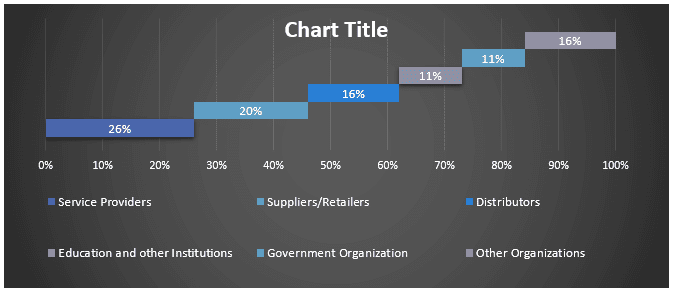
Market Engineering
The data triangulation technique was employed to complete the overall market estimation and to arrive at precise statistical numbers for each segment and sub-segment of the India Q-commerce market. Data was split into several segments & sub-segments post studying various parameters and trends in the areas of the product type, sales channel, and regions in the India Q-commerce market.
The main objective of the India Q-Commerce Market Study
The current & future market trends of the India Q-Commerce market were pinpointed in the study. Investors can gain strategic insights to base their discretion for investments on the qualitative and quantitative analysis performed in the study. Current and future market trends determined the overall attractiveness of the market at a state level, providing a platform for the industrial participant to exploit the untapped market to benefit from a first-mover advantage. Other quantitative goals of the studies include:
- Analyze the current and forecast market size of the India Q-Commerce market in terms of value (USD). Also, analyze the current and forecast market size of different segments and sub-segments.
- Segments in the study include areas of product type, sales channel, and regions.
- Define and analyze the regulatory framework for the India Q-commerce
- Analyze the value chain involved with the presence of various intermediaries, along with analyzing customer and competitor behaviors of the industry.
- Analyze the current and forecast market size of the India Q-commerce market for the major region.
- Major Regions in India studied in the report include North India, South India, East India, and West India.
- Company profile of the India Q-Commerce market and the growth strategies adopted by the market players to sustain in the fast-growing market.
- Deep dive state-level analysis of the industry
Frequently Asked Questions FAQs
Q1: What is the current market size and growth potential of the India Q-Commerce market?
Q2: What are the driving factors for the growth of the India Q-Commerce market?
Q3: Which segment has the largest share of the India Q-Commerce market by product type?
Q4: What are the emerging technologies and trends in the India Q-Commerce market?
Q5: Which region will dominate the India Q-Commerce market?
Related Reports
Customers who bought this item also bought

